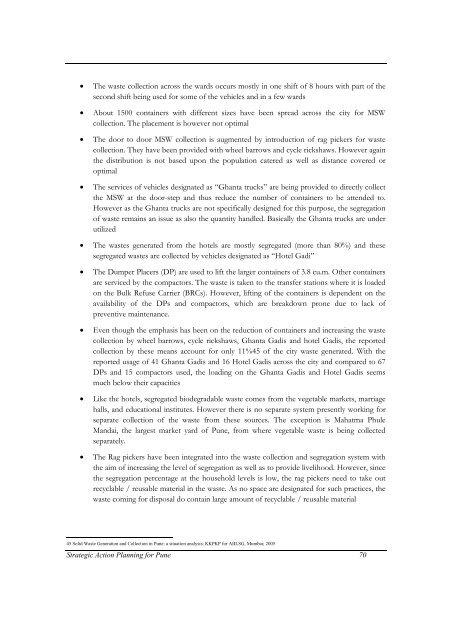Strategic Action Plan - International Environmental Technology Centre
Strategic Action Plan - International Environmental Technology Centre
Strategic Action Plan - International Environmental Technology Centre
You also want an ePaper? Increase the reach of your titles
YUMPU automatically turns print PDFs into web optimized ePapers that Google loves.
• The waste collection across the wards occurs mostly in one shift of 8 hours with part of the<br />
second shift being used for some of the vehicles and in a few wards<br />
• About 1500 containers with different sizes have been spread across the city for MSW<br />
collection. The placement is however not optimal<br />
• The door to door MSW collection is augmented by introduction of rag pickers for waste<br />
collection. They have been provided with wheel barrows and cycle rickshaws. However again<br />
the distribution is not based upon the population catered as well as distance covered or<br />
optimal<br />
• The services of vehicles designated as “Ghanta trucks” are being provided to directly collect<br />
the MSW at the door-step and thus reduce the number of containers to be attended to.<br />
However as the Ghanta trucks are not specifically designed for this purpose, the segregation<br />
of waste remains an issue as also the quantity handled. Basically the Ghanta trucks are under<br />
utilized<br />
• The wastes generated from the hotels are mostly segregated (more than 80%) and these<br />
segregated wastes are collected by vehicles designated as “Hotel Gadi”<br />
• The Dumper Placers (DP) are used to lift the larger containers of 3.8 cu.m. Other containers<br />
are serviced by the compactors. The waste is taken to the transfer stations where it is loaded<br />
on the Bulk Refuse Carrier (BRCs). However, lifting of the containers is dependent on the<br />
availability of the DPs and compactors, which are breakdown prone due to lack of<br />
preventive maintenance.<br />
• Even though the emphasis has been on the reduction of containers and increasing the waste<br />
collection by wheel barrows, cycle rickshaws, Ghanta Gadis and hotel Gadis, the reported<br />
collection by these means account for only 11%45 of the city waste generated. With the<br />
reported usage of 41 Ghanta Gadis and 16 Hotel Gadis across the city and compared to 67<br />
DPs and 15 compactors used, the loading on the Ghanta Gadis and Hotel Gadis seems<br />
much below their capacities<br />
• Like the hotels, segregated biodegradable waste comes from the vegetable markets, marriage<br />
halls, and educational institutes. However there is no separate system presently working for<br />
separate collection of the waste from these sources. The exception is Mahatma Phule<br />
Mandai, the largest market yard of Pune, from where vegetable waste is being collected<br />
separately.<br />
• The Rag pickers have been integrated into the waste collection and segregation system with<br />
the aim of increasing the level of segregation as well as to provide livelihood. However, since<br />
the segregation percentage at the household levels is low, the rag pickers need to take out<br />
recyclable / reusable material in the waste. As no space are designated for such practices, the<br />
waste coming for disposal do contain large amount of recyclable / reusable material<br />
45 Solid Waste Generation and Collection in Pune: a situation analysis; KKPKP for AIILSG, Mumbai; 2005<br />
<strong>Strategic</strong> <strong>Action</strong> <strong>Plan</strong>ning for Pune 70
















